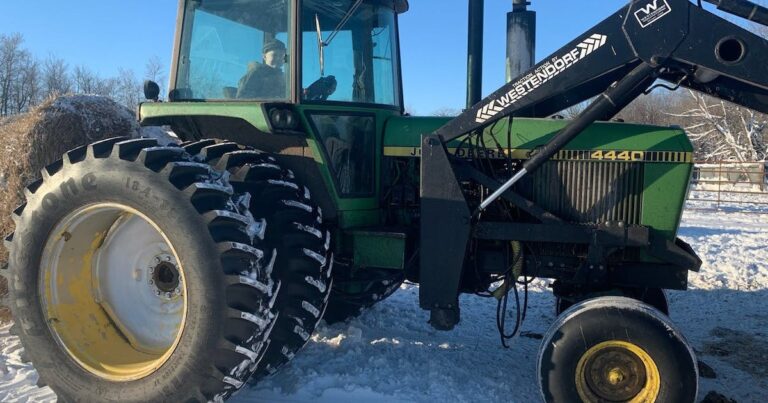Kris Folland grows corn, wheat and soybeans and raises cattle on 2,000 acres near Halma in the northwest corner of Minnesota, so his business is by no means small. But when he last bought a new tractor, he opted for an old one — a 1979 John Deere 4440.
He retrofitted it with satellite-guided automatic steering, and he and his kids can use the tractor to feed cows, plant fields and operate a grain drill. The best thing? The tractor cost $18,000, compared to over $150,000 for a new tractor. And Folland doesn't need a computer to fix it.
“This is still a very good tractor,” said Folland, who owns two other tractors built before 1982.
“They cost a fraction of the price, and then the running costs are much lower because they're much easier to fix,” he said.
Tractors built in the late 1970s and 1980s are some of the hottest items at farm auctions across the Midwest these days—and it's not because they're antiques.
Cost-conscious farmers look for bargains, and tractors of that era are well-built and functional, and not as complicated or expensive to repair as newer models that run on sophisticated software.
“It's a trend that's building. It's been interesting over the last couple of years, which have been tough for people, to see the trend accelerate,” said Greg Peterson, founder of Machinery Pete, a farm equipment data company in Rochester with Website and TV show.
“There's a kinship factor if you grew up around these tractors, but it goes way beyond that,” Peterson said. “These things, they're basically bulletproof. You can spend 15,000 hours on it and if something breaks you can just replace it.”
BigIron Auctions, based in Nebraska merchant which auctioned 3,300 pieces of farm equipment online last month, sold 27 John Deere 4440 tractors through 2019.
The model, built by Deere between 1977 and 1982 at a plant in Waterloo, Iowa, was the most popular of the company's “Iron Horse” series of tractors, which used stronger and heavier internal components to support higher-horsepower engines. The tractors featured large, safe cabs, promoting a design that first appeared in the 1960s and is now standard.
Selling one of these tractors in good condition with low hours – tractors typically last 12,000 to 15,000 hours – will start a bidding war today. A 1980 John Deere 4440 with 2,147 hours on it sold for $43,500 at a farm auction in Lake City in April. A 1979 John Deere 4640 with only 826 hours on it sold for $61,000 at auction in Bingham Lake in August.
“These older tractors that have been well taken care of and well maintained are a good asset,” said Mark Stock, co-founder of BigIron.
Tractors have enough horsepower to do what most farmers need, and even at a record price like the $61,000 the tractor fetched in Lake Bingham, it's a bargain compared to what a farmer would pay for a newer tractor with similar horsepower.
The other big advantage of older tractors is the lack of complex technology. Farmers prefer to build what they can on site or take it to their mechanic and not have to spend tens of thousands of dollars.
“The newer machines, every time something breaks, you have to have a computer to fix it,” Stock said.
There are some good things about the software on newer machines, Peterson said. The marketer will get a warning if something is going to break and can contact the farmer in advance to nip the problem in the bud. But if something breaks, the farmer is powerless, stuck in the field waiting for a service truck from the dealership to come out to his farm and charge up to $150 an hour for labor.
“That goes against pride of ownership, as well as the skills you've acquired over the course of your life to be able to fix things,” Peterson said.
Cheaper repairs for an older tractor mean their life cycle can be extended. A new engine or transmission can cost $10,000 to $15,000, and then a tractor could be good for another 10 or 15 years.
Folland has two Versatile 875s built in the early 1980s in Winnipeg and bought a John Deere 4440 last year with 9,000 hours on it, expecting to get another 5,000 hours before it needs a major overhaul.
“An expensive repair would be $15,000 to $20,000, but you're still well below the cost of buying a new tractor which is $150,000 to $250,000. It's still a fraction of the cost,” Folland said. “That's why these models are so popular. They have stood the test of time, are well built, easy to repair and easy to get parts for.”
He also said modifications to newer tractor diesel engines can cause mechanical problems, and an older tractor's carbon footprint can be mitigated by using biodiesel, which is made from soybeans grown in Minnesota and extends the life of an engine because it includes better lubricants than conventional diesel fuel.
Combine all of this with nostalgia for the tractors of a farmer's youth, and 30- or 40-year-old tractors are in high demand. That's a change from 30 years ago, Peterson said.
In 1989, 30-year-old tractors were truly antiques. A 1959 tractor at that point it would have sold for $2,000 or $3,000 and it looked like a different breed from the tractors that were running in the 1980s.
But tractors from the 1970s and 1980s aren't that dramatically different from tractors built in the 2000s, aside from annoying software, and at a time when farmers are struggling financially, older tractors can make a lot of business sense .
Folland said his corn crop was better than the Minnesota average in 2019, despite growing on the Canadian border and using 40-year-old equipment.
“The main reason we do this is to make money,” Folland said. “Older equipment is a way to lower cost per bushel to become more profitable.”

